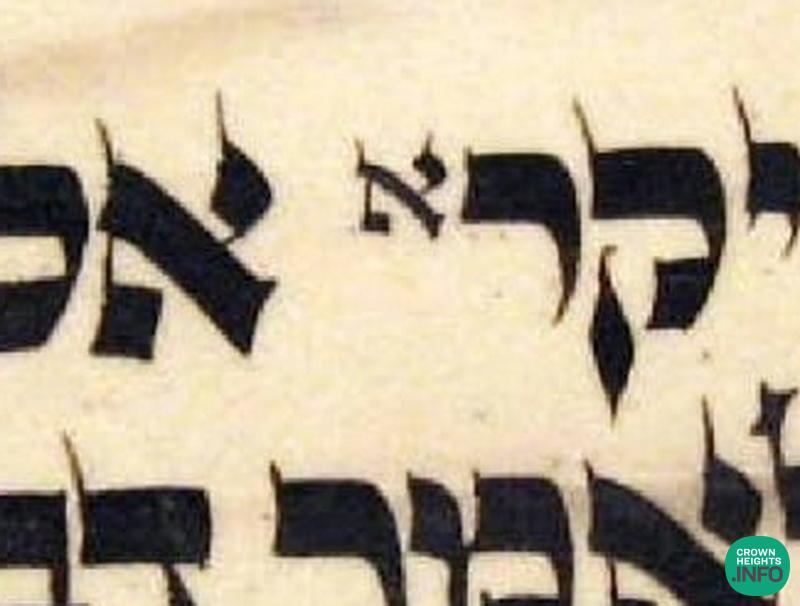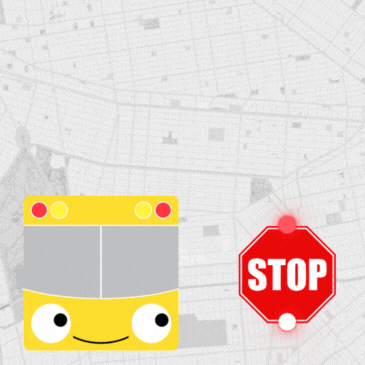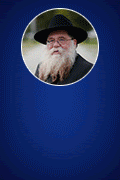
Weekly Story: The Truth Always Remains the Truth
by Rabbi Sholom DovBer Avtzon
I am posting this week a point which I mentioned at a farbrengen with mesivta (high school) age bochurim (students) during Chol Hamoed Sukkos, at a Simchas Beis Hashoeiva farbrengen.
As always, your feedback and comments and greatly appreciated and most welcomed.
It is related that when the Rebbe was in cheder his classmates were discussing the question of why the Torah begins with the letter Beis and not with an Aleph, the first letter of the Hebrew alphabet. One boy repeated the answer that Aleph is the first letter of the Hebrew word Uhroor which means curse, while the letter Beis, is the first letter of the word brocha which means a blessing. So obviously the Torah which is the source of all blessings, should begin with the letter Beis and not an Aleph.
Another boy asked, doesn’t the Aseres Hadibros- the Ten Commandments begin with the letter Aleph, of the word Anoichi, which means I [am Hashem your G-d], and the meaning of I is that it is higher than all of Hashem’s names; so you see Aleph also spells out wonderful words. He continued and said, I believe that there’s a word or two in Loshon Hakodesh that begins with the letter Beis which does not represent blessings, so we’re back to the original question of why the Torah begins a Beis and not an Aleph?
Either one of the boys asked the Rebbe what his thoughts were, or the Rebbe offered the following thought on his own.
There are two Hebrew words which have the complete opposite meaning; one is the word Emes and the other one is Sheker. Emes means the truth while Sheker means falsehood.
Emes is spelled with an Aleph, Mem and Suhf. Aleph has the numerical value of one, Mem equals forty and when you remove the zero at the end, it is four and Suhf’s value is four hundred, which once again trickles down to four. One plus four plus four equals nine.
Sheker on the other hand is comprised of the letters Shin, Koof and Reish, which have the numerical values of three hundred, one hundred and two hundred, and after removing the zeros equals 6.
So, if the Torah would begin with an Aleph, the first three letters would be Aleph, Beis and Gimmel, with the numerical value of one two and three which adds up to six. The next three letters are Daled Hei and Vov, which have the numerical value of four or five and six, which totals 15 and one and five adds up to six. Similarly, Zayin Ches and Tes is 7, 8 and 9 which adds up to 24 and 2 + 4 is once again six. These and subsequent sequences all have some connection to falsehood – Sheker.
Now let us see what happens when we begin this counting from the letter Beis which is the second letter of the Hebrew alphabet. Beis, Gimmel and Daled, is two plus three plus four, they add up to nine. The next three letters are Hei, Vov and Zayin, which equal five, six and seven and they add up to eighteen, one plus eight equals nine. While the next three letters are Ches, Tes, and Yud which equal 8, 9 and 10, which add up to 27 and 2 + 7 = 9. As mentioned, that is the numerical value of Emes -Truth!
So, we see that the Torah began with a Beis to show us that the Torah is always Emes – True. It is interesting to note that when you times 9 by any number its ultimate number will be nine, for example nine times 45, the total is 405, 4 + 0 + 5 = 9. That demonstrates that no matter where and when the Torah is, it’s applications are always true. That is the answer the Rebbe gave as a child in cheder.
The lesson to us is quite clear.
Many of us live in a different country from where our great grandparents lived, the society as well as the culture that we are living in versus the one they lived in, are vastly different, almost everything is different. The only thing that did not change is that we have the same Torah as they did.
So, while our challenges are different than theirs were, just as theirs was different than their great-grandparents were etc., but the Torah spoke the truth to them in their situation and the Torah is speaking the truth to us in our situation.
A Taste of Chassidus Likketei Torah 1a
Hashamayim Kisi
This maamar was said by the Alter Rebbe on Shabbos Mevorchim chodesh Menachem Av, however, the Tzemach Tzedek chose to place it as the first maamar of Torah Ohr, for Parshas Bereishis. Being that it is the opening maamar, I decided to write a thought (synopsis) of a main concept of it.
I believe the reason he chose to begin the sefer with this maamar, is because our sages tell us that the whole world was created because of the Torah and because of the Jewish people.
As Rashi explains, the whole creation is included in the words Es Hashamayim V’es Hu’ uretz, (as the meaning of those words are, the Heavens and everything that is included in it and the Earth and everything which is included in it. In this maamar the Alter Rebbe explains what these words “The Heavens and the Earth” mean on a spiritual level.
In short Shamayim is referring to the highest level of the Torah, which is the way the Torah is by Hashem before He gave it to us. While the Earth is referring to the mitzvos which we bnei Yisroel fulfill. The Possuk states that Hashem says the heavens is My seat and the earth is My footstool.
The Alter Rebbe asks, being that Hashem doesn’t have a physical body what does it mean that He is sitting on a chair and that His feet are resting on a footstool?
But as mentioned, the heavens are referring to the Torah and the possuk is telling us that just like when a person sits down even though his head now is closer to the Earth than it was when he was standing, but nevertheless it is the same head without any changes. The only thing is now it is a little more than a foot closer to the ground, but it is the exact same head in every aspect.
What is that telling us?
The Torah is compared to the heaven, because the Hebrew word for heaven is shamayim. Rashi explains that shamayim is a compound of the two words Eis and Mayim fire and water. Water has a tendency to descend downwards and Chassidus explains that this is a reference to kindness which also has that tendency, that the one who is above lowers themselves down to give assistance to someone who is below them.
Fire on the other hand, represents judgment and strictness.
The same thing is in the Torah, it is comprised of Chessed and Gevurah (kindness and strictness) and therefore it is comprised of 248 positive Mitzvos which represent our closeness and love to Hashem, as well.as the 365 negative Commandments, which represent the fear that we have of not going against His will.
However, that is the way the Torah came down into this world, but the essence of the Torah is on a much higher level, it is the will and desire of Hashem.
In other words, this possuk is informing us that Hashem is instructing that we should reveal that the Torah is His wisdom and not just a guideline for people how to conduct themselves.
Or in other words, being that the Torah is guiding us how to conduct ourselves in this physical world, therefore, the mitzvos are given with specific guidelines to each mitzvah, which shows limitations, since they have to be fulfilled in a world that is limited. But our mission is to reveal the infinite aspect of the Torah even in the limited world. In Chassidic terminology to reveal the soivev in the mimaleh.
The land as noted is referring to the Mitzvos. Subsequently, the meaning of the possuk will be that the mitzvos are elevating Hashem’s feet. So we have to understand what does My feet refer to. Our sages say a child is considered the foot of their father. The question is why do we refer a child (which is a reference to bnei Yisroel), to a foot when in many other places we say that a child is connected to the essence of the father’s brain?
Especially as it seems as this is alluding to something negative about the child, as there is less life and feeling in a foot compared to the rest of the body and especially to the head. Chassidus explains that nevertheless there is a tremendous quality in the foot which the head does not have, and that is what the possk is alluding to. It is telling us that through conducting ourselves as feet, we can reach / attain higher levels then if we conducted ourselves only on the aspect of a “head.” Practically speaking, a person could mentally come to a conclusion that they must go someplace, but without the mobility of the feet they could never arrive at that destination. Allegoricaly speaking, feet is sometimes ised as a metaphor for action, and as wonderful as a person’s thoughts and decisions are on how to accomplish important things and help others etc, if it remains in thought and does not come down into action it is nothing. So the possuk is informing us, that the way the Jewish people could elevate themselves and come closer to Hashem is by fulfilling the mitzvos, because the mitzvos are Hashem’s desire and desire is higher than His wisdom.
Rabbi Avtzon is a veteran mechanech and the author of numerous books on the Rebbeiim and their chassidim. He is available to farbreng in your community and can be contacted at avtzonbooks@gmail.com













Mushkie
Observations from the group:
A 9 flipped over is a 6.
This world was created in 6 days. The
Next World is Olom HaEmes. This world was created for 6000 years.
לא בגבורת הסוס יחפץ Hashem does not desire the strength of a “horse”. The word סוס is 60, 6, 60 – all 6’s. It is not desired by Hashem to be a fehrd.
A person should be גבור כארי. The word אריה is 9 (1+2+1+5). That גבורה IS desired!
Rabbi Shalom Avtzon
Your comment is interesting, but before I get to it I will add something that I did not feel is something that I should have mentioned in the article, as not everyone will know what I am talking about.
In Chassidus we say that there are four ways of spelling out the four letters of Hashem’s name. [For example, do we spell the letter Hei with a Hei and an Aleph with the numerical valueof 6, or a Hei and a Yud with the numerical value of 15.]
Depending on how all the letters are spelled we come up with Shem (the name of) Ma a Mem and a Hei (=45), Shem Bahn a Beis with a final nun, Shem Sag a Samach with a Gimmel (=63) and Shem Ahb an Ayin with a Beis (=72, and this is the holy name that was pronouncedin the Beis Hamikdash).
However, the numerical value of a Mem and a Hei without the zeros is 4 + 5 = 9, similarly a Samach and a Gimmel is 6 + 3 = 9 as does an Ayin and a Beis 7 + 2 = 9. So Hashem is Emes and even the spelling of His name is Emes.
The question is what about the name of Bahn, seemingly that is 2 + 5(0) which is seven and not nine? The answer is by the other three we have the 40 60 and 70 before the smaller number why over here is the Nuhn after the Beis?
One who is knowledgeable in numerical value of the letters of the Aleph Beis knows that a Nuhn is 50 and the final letter of Tuff is 400. Then the final Chof is 500, the final Mem is 600, while the final Nuhn is 700. Subsequently when you put the Nuhn at the end it’s 2 + 7 which equals 9 and not 5 + 2 which equals 7.
So yes all of Hashem’s names are Emes.
Concerning your comments, the thought about Hashem does not desire a horse which is a Samach, Vov Samach, 60, 6 and another 60 is well taken.
However, while the second point sounds perfect, I must take objection to it. Obviously you intended to describe the present chaos in the world, but we must look at the world as it was created.
The world was created in 6 days and the world could go on as it is up to 6,000 years, with the bitachon that the geula (Moshiach) comes way before that.
However the six days and 6,000 years all come from the six attributes of Hashem which comes from the letter Vov of Hashem’s name.
In simple words, it is complete and total holiness. This concept is emphasized in the maamar of Basi Lgani which states clearly that Hashems Shechina was completely here in this physical world. Evil only entered the world after mankind began to sin.
So to make a blanket statement that the physical world is bad, the world that gives us the ability to change it by bringing out its essence, which is of Hashem’s greatness and thereby revealing Hashem’s essenceto all, which can only be accomplished specifically in this world, and declare it a falsehood, is something that I don’t agree with.
Mushkie
Even an untrustworthy person doesn’t lie on shabbos (and is believed) because it is מעין עולם הבא, an עולם האמת, so this influences that there is no chance of שקר on shabbos.
Mushkie
The word עולם means העלם, that it conceals and hides G-dliness, which is Truth. The goal is לתקן עולם במלכות ש-ד-י, which was even before the sin, even when still in Gan Eden, the mission was לעבדו ולשמרו, to perfect the world and become a partner with the Creator.
Sholom Avtzon
If you read the A Taste of Chassidus, it is explained, to bring it to a higher level. But not chas vsholom, that it wasn’t emes until then
Mushkie
I will Hashem Willing read up on it, because in the Medrash in Vayikra Rabba 26:7, Shmuel Hanovee (when raised from the dead to speak with Saul) calls this world Olom D’sheker!
Mushkie
Yet it is c9bfusing to read the mishna in Avos chapter 1 that the world exists on din, emes and shalom (and emes is required also for the other two: din requires emes, and shalom requires emes). So if world is sheker, how is it built on emes?
Mushkie
I will Hashem Willing read up on it, because in the Medrash in Vayikra Rabba 26:7, Shmuel Hanovee (when raised from the dead to speak with Saul) calls this world Olom D’sheker!
Mushkie
Thank you, Rabbi. This topic seems fundamental and forms our perspective about our life and world around us.
Sholom Avtzon
That was said as the world existed at that moment. The whole Basi Lgani explains to change Sheker and transform.it to Keresh of the mishkan.
Crown Heightser
Deep intellectual stuff. Heavy thinking. Like ayin-bais.